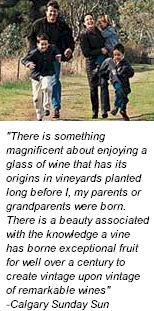


Dean Hewitson captures the essence of history and the magic in old vines and bottles it. His passion for wine is undeniable and his desire to share this passion is even greater. This led him to a life in which he creates wine purely for the enjoyment of others. Rather than purchasing vineyards, Hewitson made the savvy business decision to create long term associations with a network of established growers, allowing him to seek out the varietals he desired.

Dean Hewitson has been indeed very fortunate to be tutored by some of the best wine makers and wine scientists in the world. Having completed his degree at Roseworthy, he worked at one of Australia's best wineries, visited some of the world's best wineries experiencing fifteen vintages worldwide, and spent two years at UC Davis, California, where he completed his Masters. Through all of this, to be guided through wine evaluations and wine making techniques of the great wines by the masters themselves has certainly been a privilege and a wonderful opportunity for him. He therefore is able to draw on a very wide spectrum of ideas, practices, philosophies and experiments. These are encapsulated in his wines.
Hunting down the right varieties in the right vineyard in the right region was the next step. Each variety has been selected on the basis of being able to produce a wine of world class that, in particular, the old vineyards of South Australia are able to produce. Geographical isolation and in part a fluke of human non-intervention have preserved pre-phylloxera vineyards that are more closely linked to the original clones from Europe than anywhere on earth. Old vines from stock such as this just don't occur anywhere! With these premium parcels of fruit, Dean Hewitson has built a formidable stable of individually crafted wines, that reflect magnificent quality as well as varietal and regional quintessence.
For almost a decade now Hewitson has worked with a very small vineyard of Tempranillo at Basham’s Beach, located 30km south of McLaren Vale at the southern end of the Mount Lofty Ranges within the Adelaide Super Zone. Situated on the edge of the Fleurieu Peninsula with its strong maritime influence, the Basham's Beach vineyard has ideal climate and soils for growing this variety.

Slightly north of McLaren Vale, the hills surrounding Adelaide were planted to some of South Australia’s very first vineyards in the 1800s. Most of these disappeared as demand shifted to red varieties planted in warmer regions. However, today the cool climate and fertile slopes of the Adelaide Hills are recognized to match perfectly the demands of growing the best Sauvignon Blanc. LuLu Adelaide Hills Sauvignon Blanc demonstrates the perfect harmony with this variety and the terroir of the Adelaide Hills, displaying fresh, Sauvignon characters and crisp acidity.
In 1853 Friedrich Koch planted his Mourvèdre vineyard in the heart of the Barossa Valley in the area now known as Rowland Flat. Nurtured in deep sand over a bed of limestone the vines flourished. By the 1880s the local vignerons had already acknowledged the vineyard as the Old Garden. To the end of the 19th Century, throughout the 20th Century and now into the 21st Century subsequent generations of Koch’s family have tended these vines in the traditions of the Barossa: bush vines, no irrigation, hand pruned and hand harvested. Today nothing has changed. Old Garden is likely to be the oldest Mourvèdre vineyard in the world.
Dean Hewitson recalls being shut away in a tasting room with Len Evans, evaluating what Evans considered to be the best eight red wines in Australia at the time. As they looked at the different wines, Dean focused on descriptors, while Evans spoke of broader concepts like breeding, structure, power and the background story that gave these wines real context. This changed the way Dean thought about wine and is at the heart of everything Hewitson does today.
Hewitson's Old Garden Mourvèdre perfectly illustrated what Len Evans was talking about - uniquely expressive wines from great old vineyards, the opportunity to do the same with Shiraz was too good to pass up. This opportunity finally came in 2002. The single vineyard between Seaview Ridge and Blewitt Springs in McLaren Vale, cropping at a bit over 2 tonnes an acre has been the core of the L'Oizeau since its inception. The fruit coming off this vineyard consistently delivered what Dean felt to be the true expression of McLaren Vale Shiraz, and in 2002 it was exceptional, so the decision was made to refine and refocus it. The single vineyard flagship wine was born, Hatter is actually the nickname Dean's closest friends have used for years, and as for the Mad, well those who've spent any more than 5 minutes with the man will surely understand.
